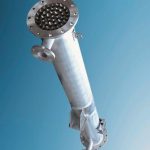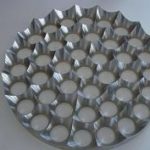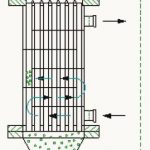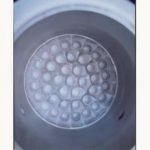The compact Bulk-X-Change heat exchanger allows all kinds of free-flowing, non-caking powders and pellets to be efficiently heated or cooled. This tubular device can be installed in system sections which make use of gravitational force or directly in a pneumatic conveying system.
Reinhard Ernst, Dr. Bernhard Stark
In many bulk solids processing systems thermal treatment of the product is required. It is often necessary to heat the product during a production process, for example for degassing, crystallisation, drying of internal or external moisture, prevention of condensation or preparation for downstream thermal processing sections (such as extrusion). Cooling can be necessary, for example, if the production temperature is high but the solids are processed downstream at a lower temperature.
Thermal treatment
There are different technical solutions for the thermal treatment of bulk solids. Both direct and indirect processes are possible. During a direct process the bulk solid is exposed to an immediate flow of air or gas as a heat transfer medium. This is performed in silos equipped with aeration units or correspondingly equipped shaft, drum or fluidising bed devices. Direct processes, which use a flow of gas, are ideal if the process is used for separating large quantities of a volatile substance, i.e. for drying surface moisture, as the molecules requiring separation are carried away with the gas flow. Furthermore, fluidised bed coolers/heaters are particularly suitable for products with negative flow properties, as the gas flow loosens the solid and makes it easier to handle. The disadvantage of these processes is that both the solid and the gas have to be set in motion, which means that a blower is necessary. As gases have a low thermal capacity, relatively high flow rates are essential. This results in high power consumption as well as a complicated overall installation with large space requirements.
During indirect processes the heat is exchanged through a separating wall, with water, oil or steam as the heat transfer medium. This type of heat exchanger is often made up of pipes or plates. A jacketed pneumatic conveying line can also be used as a heat exchanger. When free-flowing products are heated or cooled and the process runs in continuous mode, a heat exchanger is more advantageous than the direct processes. The high thermal capacity of a liquid as a heat transfer medium means that the equipment required with heat exchangers is much less complex, the investment and operating costs are much lower and less constructional space and installation area is necessary. As no moving parts are fitted, the servicing requirements are comparatively low and the risk of failure is minimal. Heat exchangers are also very suitable for inert processes, as the device only has to be blanketed with a low quantity of the inert gas, normally nitrogen. The simple control of a heat exchanger is also a noteworthy factor, due to the fact that apart from the temperature only the filling level requires monitoring during continuous operation.
Gravitational force
These advantages are fully utilised in the Bulk-X-Change bulk solids heat exchanger developed by Coperion Waeschle. The tubular heat exchanger can be used for heating and cooling free-flowing, non-caking powders and pellets. The bulk solid flows vertically downwards through an upright pipe arrangement due to gravitational force, while the liquid heat transfer medium flows around the pipes in the shell. A bulk solid mass above the pipes, which is monitored by a level indicator system, ensures that each pipe is fully filled. A rotary valve regulates the bulk solid flow during discharge. The planned unit sizes cover a performance range from a few 100 kg/h to approximately 150 t/h for plastics. The tonnage is correspondingly higher for heavy products.
Efficient heat transfer
The tubular heat exchanger is distinguished by its particularly efficient heat transfer qualities. The dense pack of slim tubes ensures the greatest specific heat transfer surface of all bulk solids heat exchangers. In a round tube the heat flows radially in all directions over the entire circumference. The fluid is routed in a crosswise counter-flow by means of guide plates in the shell. As a result, a uniform effect is achieved over the complete cross-section and optimum utilisation of the height of the pipes is ensured.
An additional major feature of the Bulk-X-Change heat exchanger is the special method of product infeed above the tubes. The inlet into each tube is machined out of the plate in the form of a funnel and arranged so that there is no horizontal surface between two funnels. This ensures that the product is fed equally into all tubes and the dwelling time is the same. Emptying of the heat exchanger is completed without residues, as it is not possible for product to be deposited anywhere on the distributor plate.
Compact unit
As a result of the excellent heat transfer efficiency and the large surface which the design provides, the heat exchanger is a very compact unit. In comparison to other contact heat exchanger designs Bulk-X-Change has a number of additional advantages. The smooth pipes through which the product flows can be very easily cleaned with conventional brushes or a steam/water-operated nozzle. The tubes of the tubular heat exchanger can also be very simply washed or flooded with water. If the top section is removed, the entire area in contact with the product is fully visible and can therefore be inspected. Pressure resistance can easily be achieved due to the round design. The tubular heat exchanger can therefore also be used for drying in positive or negative pressure systems. Bulk-X-Change can moreover be used in the high-temperature range. To this purpose the shell can be equipped with an expansion joint to compensate for thermal stress. The heat transfer from the bulk solid to the pipe wall can be augmented with the aid of internal rib pipes, especially with free-flowing powders.
Low abrasion
In the tubular heat exchanger the product flows very slowly and at a very low product pressure. The mechanical stress on the bulk solid particles is therefore very low. As a result, damage to the particles is negligible, which means that no fines are produced. The process is therefore especially suitable for fragile products and those which are susceptible to abrasion, such as spray-dried powder. Due to the low flow velocity in the pipes the tubular heat exchanger is also ideal for abrasive bulk solids. Bulk-X-Change can additionally be used as a dryer for small quantities of internal and external moisture. To this purpose an additional flow of gas is blown through the pipes into the product chamber, rising at a low velocity in the opposite direction from the bulk solid flow to remove moisture.
Design specifications
The bulk solid heat exchanger is normally used in a system section which makes use of gravitational force or in the infeed section of a pneumatic conveying system. If there is a differential pressure in the discharge valve and leakage air occurs as a result, leakage air venting must be installed above the rotary valve to prevent an uncontrolled counter-flow into the heat exchanger. A very interesting variant is the integration of the heat exchanger in a pneumatic conveying line. This is advantageous when the overhead height is insufficient to install the heat exchanger above the pick-up point of the pneumatic conveying system or if the conveying route length is insufficient for product cooling in the pneumatic conveying line with a jacketed pipe. The top section of the heat exchanger is a separator into which the pneumatic conveying line opens. An overflow opening leads to a bypass pipe through which the conveying air and a residual quantity of conveyed product flows around the heat exchanger. The main volume of the conveyed product passes through the tubes due to gravitational force and is heated or cooled. Below the discharge valve the conveying gas flow re-enters the main pipe and picks up the flow of product once more. The bypass is generously dimensioned so that the pressure drop is negligible. The discharge valve and the heat exchanger therefore work without any noteworthy difference in pressure and as a result without leakage air. The speed of the discharge valve is set so that its capacity is somewhat lower than the overall conveyed volume. The resulting initiated overflow of a small residual quantity ensures that the necessary bulk solid mass is always available above the tubes without any technical monitoring of the filling level. An integrated bypass line with two diverter valves permits continuation of the conveying process while the heat exchanger is being serviced.
cpp 425
More information on the product
Calculation program used for the design of pneumatic conveying systems
Bulk-Online
Powtech 2005
Share:










